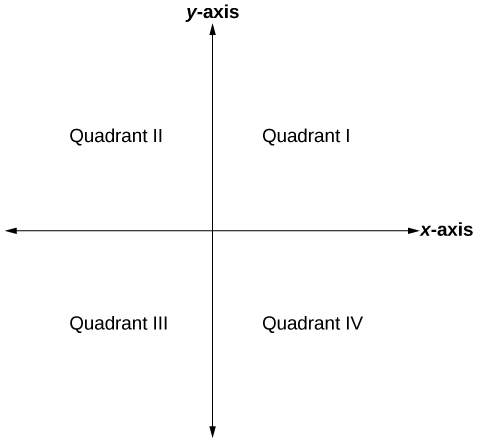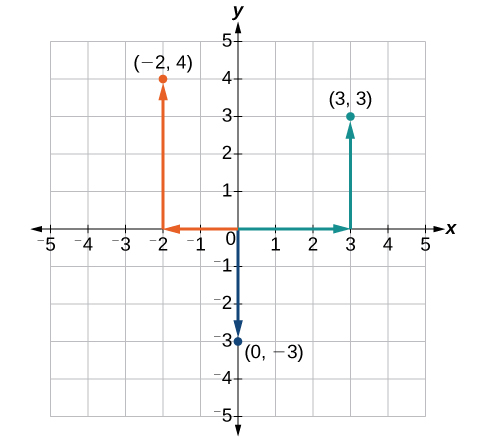Plotting Points on the Coordinate Plane
Learning Outcomes
- Define the components of the Cartesian coordinate system.
- Plot points on the Cartesian coordinate plane.
 The Cartesian coordinate system with all four quadrants labeled.
The Cartesian coordinate system with all four quadrants labeled.Try It
[ohm_question]92752[/ohm_question] Each point in the plane is identified by its x-coordinate, or horizontal displacement from the origin, and its y-coordinate, or vertical displacement from the origin. Together we write them as an ordered pair indicating the combined distance from the origin in the form [latex]\left(x,y\right)[/latex]. An ordered pair is also known as a coordinate pair because it consists of x and y-coordinates. For example, we can represent the point [latex]\left(3,-1\right)[/latex] in the plane by moving three units to the right of the origin in the horizontal direction and one unit down in the vertical direction.
Each point in the plane is identified by its x-coordinate, or horizontal displacement from the origin, and its y-coordinate, or vertical displacement from the origin. Together we write them as an ordered pair indicating the combined distance from the origin in the form [latex]\left(x,y\right)[/latex]. An ordered pair is also known as a coordinate pair because it consists of x and y-coordinates. For example, we can represent the point [latex]\left(3,-1\right)[/latex] in the plane by moving three units to the right of the origin in the horizontal direction and one unit down in the vertical direction.
 An illustration of how to plot the point (3,-1).
An illustration of how to plot the point (3,-1).A General Note: Cartesian Coordinate System
A two-dimensional plane where the- x-axis is the horizontal axis
- y-axis is the vertical axis
Example: Plotting Points in a Rectangular Coordinate System
Plot the points [latex]\left(-2,4\right)[/latex], [latex]\left(3,3\right)[/latex], and [latex]\left(0,-3\right)[/latex] in the coordinate plane.Answer:
To plot the point [latex]\left(-2,4\right)[/latex], begin at the origin. The x-coordinate is –2, so move two units to the left. The y-coordinate is 4, so then move four units up in the positive y direction.
To plot the point [latex]\left(3,3\right)[/latex], begin again at the origin. The x-coordinate is 3, so move three units to the right. The y-coordinate is also 3, so move three units up in the positive y direction.
To plot the point [latex]\left(0,-3\right)[/latex], begin again at the origin. The x-coordinate is 0. This tells us not to move in either direction along the x-axis. The y-coordinate is –3, so move three units down in the negative y direction.

Analysis of the Solution
Note that when either coordinate is zero, the point must be on an axis. If the x-coordinate is zero, the point is on the y-axis. If the y-coordinate is zero, the point is on the x-axis.Try It
[ohm_question]92753[/ohm_question]Try it
You can use an online graphing calculator to practice plotting points on the Cartesian Coordinate plane. Watch the following short video to learn how! https://youtu.be/eS6kabG2omI?list=PLfM6zMGnbgOGLZc-_Yj3QVK3Vz_L4Cw59 Now try plotting the following points with an online graphing calculator. [latex-display](4,0)[/latex-display] [latex-display](-1,5)[/latex-display] [latex-display](0,-10)[/latex-display] [latex-display](2,7)[/latex-display] [latex-display](3,-5)[/latex-display] [latex-display](-4,-7)[/latex-display]Licenses & Attributions
CC licensed content, Original
- Revision and Adaptation. Provided by: Lumen Learning License: CC BY: Attribution.
CC licensed content, Shared previously
- College Algebra. Provided by: OpenStax Authored by: Abramson, Jay et al.. License: CC BY: Attribution. License terms: Download for free at http://cnx.org/contents/[email protected].
- Learn Desmos: Points. Authored by: Desmos. License: All Rights Reserved. License terms: Standard YouTube License.
- Question ID 92752, 92753. Authored by: Michael Jenck. License: CC BY: Attribution. License terms: IMathAS Community License, CC-BY + GPL.
CC licensed content, Specific attribution
- College Algebra. Provided by: OpenStax Authored by: OpenStax College Algebra. Located at: https://cnx.org/contents/[email protected]:1/Preface. License: CC BY: Attribution.
